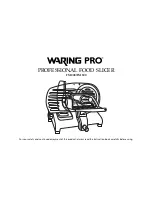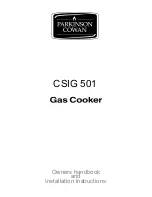
15
CHICKEN STOCK
Hot Pack: Place large carcass bones in a large pot; add enough water to cover bones. Cover pot and
simmer 30 to 45 minutes or until meat can be easily removed from bones. Remove bones.
Cool broth; skim off and discard fat. Remove bits of meat from bones and add to broth, if de-
sired. Reheat broth to boiling. Fill hot jars with hot broth, leaving 1-inch headspace. Remove
air bubbles. Clean jar rims. Position lids and secure with bands.
Dial Gauge Canner:
Process at 11 pounds pressure, pints 20 minutes and quarts 25 minutes . For process-
ing above 2,000 feet altitude, see page 12 for recommended pounds pressure .
Weighted Gauge Canner:
Process at 10 pounds pressure, pints 20 minutes and quarts 25 minutes . For
processing above 1,000 feet altitude, see page 12 for recommended pounds pressure .
SOUPS
Vegetable, Dried Bean or Pea, Meat, Poultry, or Seafood*
Choose your favorite vegetables, dried beans or peas, meat, poultry, or seafood ingredients for soup as long
as those ingredients have their own individual canning recommendations. Do not use ingredients for which
there are no canning recommendations .
CAUTION!
In accordance with USDA guidelines, do not add noodles or other pasta, rice, flour, cream,
milk, or other thickening agents to home canned soups as processing time may not be adequate .
Hot Pack: Prepare vegetables, meat, poultry, and seafood as described in the hot pack directions for the
individual ingredients .
If dried beans or peas are used, they must be fully rehydrated
before adding to other ingredients
(see page 8). Combine solid ingredients with meat broth,
tomatoes, or water to cover. Boil 5 minutes. Salt to taste, if desired. Fill jars halfway with
solid ingredients and then add soup liquid, leaving 1-inch headspace. Remove air bubbles.
Clean jar rims. Position lids and secure with bands.
Dial Gauge Canner:
Process at 11 pounds pressure, pints 60 minutes and quarts 75 minutes . For process-
ing above 2,000 feet altitude, see page 12 for recommended pounds pressure .
Weighted Gauge Canner:
Process at 10 pounds pressure, pints 60 minutes and quarts 75 minutes . For
processing above 1,000 feet altitude, see page 12 for recommended pounds pressure .
*
Note:
Cooked seafood can also be added as part of the solid mixture, but the processing time must be increased
to 100 minutes for pints and quarts .
HELPFUL HINTS FOR PRESSURE CANNING
♦ Bubbles often appear in the jar after removal from the canner because food is still boiling in the jar. Ordinarily bubbles do not ap-
pear once the product has been allowed to thoroughly cool .
♦ Jar breakage during processing is caused by: (1) packing jar too solidly or overfilling; (2) weakened, nicked, or chipped jars;
(3) jars touching bottom of canner; (4) failure to tighten screw bands according to manufacturer’s directions; (5) use of jars other
than Mason jars.
♦ Liquid lost from jars during processing is caused by: (1) packing jar too solidly or overfilling; (2) insufficient exhaust period; (3) air
was exhausted too vigorously during the 10-minute venting period; (4) variation or sudden reduction of pressure in the canner;
(5) failure to tighten screw bands according to manufacturer’s directions.
If liquid is lost during processing, do not open jar to replace liquid. Loss of liquid will not cause spoilage, but food above the liquid
will discolor. If at least half of the liquid is gone, place the jar in the refrigerator and use the food within 2 to 3 days.
♦ Flat sour, a type of food spoilage, is caused by canning overripe food or allowing precooked foods to stand in jar too long before
processing . It may be prevented by using fresh products and properly processing, cooling, and storing . Flat sour shows no indication
of spoilage until jar is opened. Discard contents.
♦ Food spoilage or jars not sealing is caused by: (1) failure to follow exact timetables and recipes; (2) failure to wipe sealing edge of
jar clean before placing lid on jar; (3) foods, seeds, or grease lodged between lid and jar; (4) jars which are nicked, cracked, or have
sharp sealing edges; (5) failure to tighten screw bands according to manufacturer’s directions; (6) turning jars upside down while
jars are cooling and sealing.
♦ Mold can form only in the presence of air. Therefore, jars are not sealed if mold is present. Discard contents.
♦ If a jar does not seal, refrigerate it and use the food within 2 to 3 days. Otherwise, reprocess or freeze the food within 24 hours.
Freeze or repack using new lids. Reprocess for the full recommended processing time.
♦ The black deposit sometimes found on the underside of a lid is caused by tannins in the food or hydrogen sulfide which is liberated
from the food by the heat of processing . This does not indicate spoilage .



































